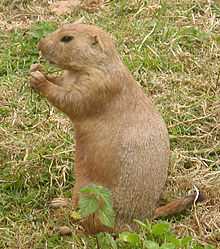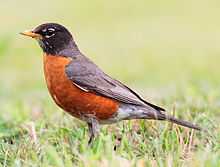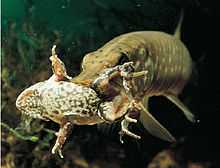Fauna of Saskatchewan


The Fauna of Saskatchewan include several diverse land and aquatic animal species. From the multiplicity of invertebrates and vertebrates, two have been chosen as symbols of Saskatchewan.[1] Cenozoic vertebrate fossils reveal the geological evolution of the interior plains and its prehistoric biogeography.[2] Today, Saskatchewan's ecosystems range from the sub-arctic tundra of the Canadian Shield in north Saskatchewan to aspen parkland, the Mid-Continental Canadian forests in the centre of the province and grassland prairie.[3] Fauna inhabit areas unique to their own specific and varied breeding, foraging and nesting requirements.[4] With a large land and water area, and small population density, the ecoregions of Saskatchewan provide important habitat for many animals, both endangered and not.[5] Naturalists observing wildlife have enumerated shrinking and growing wildlife populations. They advocate programs and methods to preserve or re-introduce endangered species and identify programs of control for outbreaks of wildlife populations.[6] A broad diversity of wildlife habitats are preserved as parks and reserves protecting the feeding and breeding grounds of protected and indigenous fauna of Saskatchewan.[2][7]
Provincial symbols
The Sharp-tailed Grouse (Pedioectes phasianellus jamesi) was declared the symbol of Saskatchewan in 1945.[8][9] As of 2001, the provincial Animal is the White-tailed deer (Odocoileus virginianus).[10]
Ancient fauna - paleontology

Fossils have been uncovered which have dated back to the Paleocene, Eocene, Oligocene, Miocene, and Pleistocene periods. These Cenozoic vertebrates include mammals, amphibians and reptiles. There have been fossils of birds unearthed as well which have dated back (55.8±0.2 to 33.9±0.1 Ma) to the Eocene and 23.03 to 5.33 Ma to the Miocene period.[11] Historically mammoths and mastodons roamed the plains which migrated across the Bering land bridge from Eurasia. Black bear, Bison antiquus, Bison latifrons, bobcat, Bos bison, caribou, cheetah, Columbian mammoth, elk, grizzly bear, horse, ice age elephant, llama, lion, moose, one-hump camel, pronghorn, saber-toothed cat steppe bison (Bison priscus), white-tail and mule deer, wooly mammoth populated the plains in pre-historic eras.[12] American Bison, commonly known as "buffalo" is the largest and most notable mammal found in Saskatchewan dating back to its ancestors Bison antiquus, and Bison latifrons.[13] Large reptiles such as Mosasaur, Plesiosaur, Ichthyosaur and Sea Turtle lived in the seas which covered Saskatchewan, Triceratops fossils were also unearthed.[14][15] A scampering non-hopping rabbit Palaeolagus temnodon and Megalagus were some of the Eocdene-Oligocene mammalian paleofauna uncovered at the Cypress Hills Formation of Saskatchewan. An abundance of Calf Creek Local Fauna has been unearthed at the Cypress Hills Formation. Eastend is about 16 kilometres (9.9 mi) southeast of this site. The following microvertebrates have been located Daphoenacyon dodges, Daphoenus, Daphoenine or bear-dog; Parictis parvas, P. Nimravid or small bear; Hesperocyon gregarious or small fox-dog; Hemipsalodon grandis or subjective synonym of Pterodon,[16] and Hyaenodon horridus H. microdon or carnivorous hyaena.[2][17][18] Artiodactyls are even toed hoofed mammals such as deer, pigs, camels, goats and cattle.[19]:4 Among the 53 mammalian taxa of fossils from the Swift Current area are the Cypretherium coactatum or terminator pig[19]:4;[20] Ibarus storer, I. ignotus, or herbivorous fast running small deer the size of a rabbit[19]:55; Merycoidodon culbertsoni Leidy or camel type mammal that lived in herds[19]:158; Limnenetes anceps or a cud chewing plant eating sheep sized hippopotamus[19]:159; Hendryomeryx esulcatus,[11] Leptomeryx speciosus and L. mammifer or small hornless ruminant;[11][21] Didelphodus serus[11] or meat eating marsupial about the size of a Virginia Opossum or house cat; Thylacaelurus campester;[11] Wallia scalopidens is a fossilised proscalopid insectivore bat;[11][22] Auxontodon processus;[11][23] Microparamys solidus[11] The Cretaceous–Paleogene boundary marks the Cretaceous–Paleogene extinction event which saw the extinction of many of these prehistoric animals which remain only as fossil remnants.[24]
Native species
Vertebrates
Mammals - Mammal fauna
Mammal species differ between the various ecoregions of Saskatchewan. Members of six orders of placental mammals which inhabit Saskatchewan. They are the bats, carnivores (including the pinnipeds), artiodactyls, cetaceans, insectivores, and rodents (including the lagomorphs).[13]
The Athabasca Plain ecoregion supplies lichen as winter forage for the woodland caribou. The arctic fox as their predator is also found in this region.[13] As well as the mammals of the Taiga Shield ecozone, little brown myotis (Myotis lucifugus), Canadian lynx (Lynx canadensis), timber wolf, Canadian beaver (Castor canadensis), muskrat (Ondatra zibethicus) are found in the Boreal Shield ecozone[7][31][32][33]
The beavers dam small streams throughout Saskatchewan. The muskrat and beaver were exploited for their fur and beaver pelts. Beavers are still trapped for the fur trade industry and were almost extirpated in the first half of the 20th century.[34] The Mid-Boreal Upland ecoregion within the Boreal Plains Ecozone features White-tailed deer (Odocoileus virginianus), mule deer (Odocoileus hemionus), big brown bat (Eptesicus fuscus), silver-haired bat (Lasionycteris noctivagans) and the other mammals of the northern boreal forests.[7][7][35][36][37] There is a lower population of mammalian wildlife amidst the fens, marshes, bogs and swamps that demark the muskeg area of the Mid-Boreal Lowland.[38] The large mammals of the northern Taiga Shield and Boreal ecozones can still be supported in this transitional area, however elk, reindeer, wolf are animals of the boreal forest.
As well smaller mammals such as Keen's myotis (Myotis keenii), northern flying squirrel (Glaucomys sabrinus), fisher (Martes pennanti), ermine (Mustela erminea), North American river otter (Lontra canadensis), least chipmunk (Tamius minimus) and short-tailed shrew (Blarina brevicauda) are sighted along with snowshoe hares, white-tailed deer in the Boreal Transition ecoregion. Carnivores which prey on these creatures such as lynx and wolves are also located in the area.[7][39][40][41][42]
The Aspen Parkland is agricultural land. The most prominent wildlife species which may be found are coyote (Canis latrans), hare, striped skunk (Mephitis mephitis), North American porcupine (Erethizon dorsatum), Richardson's ground squirrel (Spermophilus richardsonii), snowshoe hare, cottontail (Sylvilagus floridanus), northern pocket gopher (Thomomys talpoides), Franklin's ground squirrel (Spermophilus franklinii) and red fox. The Aspen Parkland is the environment of choice for the White-tailed deer.[7][34][40][43][44][45][46]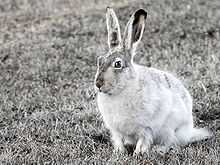
Birds - Avifauna
Across Saskatchewan there are breeding, wintering, migration, breeding and wintering, and summering (non-breeding) grounds for 414 species of birds.(recorded 1998) migrants follow flyways which can be determined by banding.
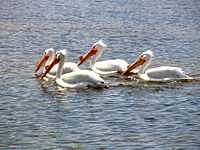
Amphibians and reptiles - Herpetofauna

Typical reptiles in the Mixed Grassland ecoregion are the horned lizard (Phrynosoma), common garter snake (Thamnophis sirtalis), Common Snapping Turtle (Chelydra serpentina), and prairie rattlesnake, and western painted turtle (C. p. bellii).[4][52][53][54][62] The Leopard frogs (Rana pipiens) and chorus frogs (Pseudacris) are typical amphibians of the Grasslands National Park.[63]
Fish - Ichyofauna
The Lake trout (Salvelinus namaycush), Arctic grayling (Thymallus arcticus), White sucker (Catostomus commersoni), Longnose sucker (Catostomus catostomus), burbot (Lota lota), lake herring(Coregonus artedi), Lake whitefish, (Coregonus clupeaformis), walleye or pickerel (Sander vitreus), and northern pike (Esox lucius) are fish found in the freshwater lakes in Saskatchewan.[26][27][58][64][65] Perch (Perca flavescens) swim alongside the Northern pike, walleye, lake trout in the Mid-boreal lowland.[58] The Lake sturgeon (Acipenser fulvescens), goldeye (Hiodon alosoides), and bigmouth buffalo (Ictiobus cyprinellus) are fish species of the Saskatchewan river.[7] Streams and ponds throughout the Saskatchewan prairies may be stocked with rainbow trout (Oncorhynchus mykiss), brook (Salvelinus fontinalis), and brown trout (Salmo trutta morpha fario and S. trutta morpha lacustris).[55] Catfish (Sluriformes) and carp (Cyprinidae) range through the Frenchman river.[63]There are significant commercial fisheries for both freshwater and salt-water species. The Fort Qu'Appelle Fish Culture Station stocks lakes and streams in this way winter killed lakes are replenished.[4][7]
Invertebrates

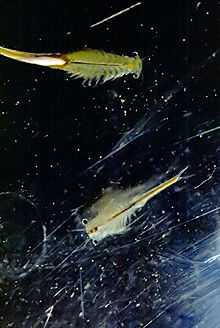
Invasive species
The zebra mussel (Dreissena polymorpha), a non-native species is currently posing a serious threat to Saskatchewan waterways, as it has overtaken nearby freshwater habitats.[69]
During the 1930s gophers (Richardson's ground squirrel, Spermophilus richardsonii, and thirteen-lined ground squirrel, Spermophilus tridecemlineatus) by the thousands were eating crops and burrowing holes which injured horses. The government offered a nickel for every tail turned in.[70][71]
The Rocky Mountain locust (Melanoplus spretus) was a small invertebrate which darkened the skies. In 1875 they covered the American and Canadian plains eating everything in the grasslands. By 1902 they disappeared mysteriously and went extinct.[72] Growing resistant crops, and utilising oats and peas are new methods of control where and when there are Grasshopper (Camnula pellucida) outbreaks.[73]Protected species
The burrowing owl (Athene cunicularia hypugaea) is an endangered species.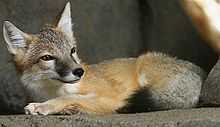

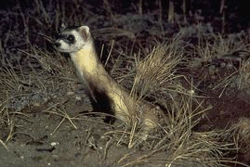
Associated with the irradication program of the prairie dog (gopher) in the 1930s was the dramatic decline in population of the black-footed ferret (Mustela nigripes) which relied on the prairie dog as its main source of food. The lowered population was hastened as the natural habitat of the ferret was also being taken over by agricultural machinery and practices.[70][71][83]
Biodiversity conservation
Chaplin, Old Wives, Reed Lakes (Hemispheric) - Western Hemisphere Shorebird Reserve Network (WHSRN) Site is a designated Hemispheric Shorebird Reserve Network protecting three saline lakes, saline and freshwater marshes. This area is a breeding site for the endangered Piping Plover. 67,000 other birds in over 30 species make use of this area.[2][84] The Prince Albert National Park affords protection to a breeding ground of the American White Pelican which has been designated as a threatened species.[85][86] Quill Lakes International Bird Area whch houses over one million shorebirds annually is a RAMSAR international wetlands area recognized by the Western Hemisphere Shorebird REserve Network Site (WHSRN).[86] Redberry Lake World Biosphere Reserve is a United Nations saline lake bird sanctuary.[87]Last Mountain Lake or Long Lake the first federal bird sanctuary, and the Dundurn Military Reserve are preserved areas of natural habitat. Protected areas include Cypress Hills Provincial Park, Douglas Provincial Park, Danielson Provincial Park, Blackstrap Provincial Park, Pike Lake Provincial Park. Approximately 80% of the werlands in this ecoregion have been lost.[50][86] The only Canadian colony of prairie dogs is protected in the Grasslands National Park.[63][84] Ord's kangaroo rat (Dipodomys ordii) is found only in the Great Sand Hills. High populations of sharp-tailed grouse and mule deer reside in the Great Sand Hills area.[88] The Aspen Parkland has been mainly converted to agricultural cropland and grazing lands. Bronson Forest is original parkland, Pasquia Hills provincial forest, Porcupine Forest, and Nisbet Forest are reserved tracts of land.[46][89]
Highways are threat to wildlife populations. The porcupine's defense mechanism against predators is to crouch and raise quills which results in highway accidents and roadkill of this rodent.[34] Deer and other large ungulates are a hazard to traffic resulting in potential animal or human deaths especially in the autumn mating months or when deer are searching for feeding grounds in the spring. The defense mechanism of deer in the face of a threat is to freeze. There are over 3,500 deer - auto collisions per year in Saskatchewan.[90] A number of measures have been implemented to increase awareness such as fencing, feeding programs, automobile whistles.[90] Saskatchewan Wildlife Federation has launched "Slow Down and Save a Buck" sign campaign.[91] Deer mirrors along the edges of highways were installed for reducing deer-vehicle collisions.[92] The Wildlife Warning System is triggered by highway vehicles, setting off lights, sounds and or odours ahead of the approaching vehicle to frighten away animals. A system that detects vehicle was installed in 2002 near Harris to reduce the quantity of mule deer - automobile accidents for a two year testing period.[93] Another system detects large animals and sets off a warning system to drivers of vehicles alerting them that an animal is on or near the highway ahead of time.[90][94]The major threats to natural habitat are logging, pesticide use and oil and gas exploration.[46][89] Destruction of habitats by forestry or agriculture change population levels. Removal of forests raising prairieland increases the population of Aspen Parkland and prairie habitat animals. Increasing prairieland and reducing the boreal forest reduces animals which depend on the forest for survival. Trapping, shooting and poisoning are direct threats to mammals. Dumping sand, clearing vegetation on shorelines, leaking septic tanks, dams and weirs are threats to fish populations.[4] Removal of forests to increase agricultural lands creates a habitat loss which is a threat to the avifauna population.[4]
Naturalists
Peter Fidler (1769–1822) naturalist, surveyed and mapped Saskatchewan and wrote reports on wildlife observation.[6] Loring Woart Bailey (1839–1925), naturalist studied algae and identified diatoms in Saskatchewan.[6]:47 Archibald Stansfeld Belaney, Grey Owl (1888–1938) conservationist lived in the Prince Albert National Park and appeared in films advocating wildlife preservation.[6]:73
See also
- List of mammals in Saskatchewan
- Flora and fauna of the Maastrichtian stage
- Prehistoric birds of North America
- Wildlife of Canada
- Western Economic Diversification Canada
References
- ↑ "Images of a Province: Symbols of Saskatchewan". Publications Centre > Intergovernmental Affairs > Images of a Province: Symbols of Saskatchewan. Government of Saskatchewan. 2005-04-11. Retrieved 2009-01-26.
- ↑ 2.0 2.1 2.2 2.3 "Royal Saskatchewan Museum: Publications: Earth Sciences" (Abstract published online by JSTOR 2000-2008). Royal Saskatchewan Museum. 2009. Retrieved 2009-01-25.
- ↑ "Saskatchewan Conservation Data Centre". Saskatchewan Conservation Data Centre. 2002. Retrieved 2009-01-25.
- ↑ 4.0 4.1 4.2 4.3 4.4 4.5 4.6 4.7 ThorpeWapple, Robert (1999). "Wildlife". In Kai-iu Fung, Bill Barry, Wilson, Michael. Atlas of Saskatchewan Celebrating the Millennium. Andrew B. Didiuk Alan Smith, Bernie Gollop, Jennifer Merkowsky, Peter Jonker (Millennium ed.) (Saskatchewan: University of Saskatchewan). pp. 138–168. ISBN 0-88880-387-7.
- ↑ "Narrative Descriptions of Terrestrial Ecozones and Ecoregions of Canada". The Green LaneTM, Environment Canada's World Wide Web site. Government of Canada. 2005-04-11. Retrieved 2009-01-26.
- ↑ 6.0 6.1 6.2 6.3 6.4 Sterling, Keir Brooks; C. Stuart Houston (1997). Biographical Dictionary of American and Canadian Naturalists and Environmentalists (Digitized online by Google books) (illustrated ed.). Greenwood Publishing Group. pp. 267–269. ISBN 9780313230479. Retrieved 2009-01-25.
- ↑ 7.0 7.1 7.2 7.3 7.4 7.5 7.6 7.7 7.8 7.9 7.10 7.11 7.12 Maher, W.J. (1969). "Zoogeography". In J.H. Richards, K.I. Fung. Atlas of Saskatchewan. F.J. Atton, J.B. Gollop. Saskatoon, SK, CA: University of Saskatchewan. pp. 79–105.
- ↑ Government of Saskatchewan (June 2008). "Saskatchewan's Provincial Bird". Retrieved 2008-06-01.
- ↑ Comox School District. "Saskatchewan". Retrieved 2007-04-05.
- ↑ Government of Saskatchewan (June 2008). "Saskatchewan's Provincial Animal". Retrieved 2008-06-01.
- ↑ 11.0 11.1 11.2 11.3 11.4 11.5 11.6 11.7 "Royal Saskatchewan Museum: Publications: Earth Sciences". Royal Saskatchewan Museum. 2009. Retrieved 2009-01-25.
- ↑ Savage, Candace; James R. Page (2006). Prairie: A Natural History (Digitized online by Google books) (reprint, illustrated ed.). Greystone Books. pp. 57–58. ISBN 9781553651901. Retrieved 2008-01-21.
- ↑ 13.0 13.1 13.2 Secoy, Diane (2006). "Bison". Encyclopedia of Saskatchewan; Canadian Plains Research Center, University of Regina. http://esask.uregina.ca/entry/bison.html. Retrieved 2009-01-06.
- ↑ Currie, Philip J.; Eva Bundgaard Koppelhus (2005). Dinosaur Provincial Park: A Spectacular Ancient Ecosystem Revealed (Digitized online by Google books) (illustrated ed.). Indiana University Press. p. 243. ISBN 9780253345950. Retrieved 2009-01-25.
- ↑ Acorn, John; Royal Tyrrell Museum of Palaeontology (2007). Deep Alberta: fossil facts and dinosaur digs (Digitized online by Google books) (illustrated ed.). University of Alberta. p. 157. ISBN 9780888644817. Retrieved 2009-01-25.
- ↑ "The Paleobiology Database". Taxonomic names from W. D. Matthew 1909. 2009. Retrieved 2009-01-25.
- ↑ Bryant, Harold N. (Nov 1993). "Carnivora and Creodonta of the Calf Creek Local Fauna (Late Eocene, Chadronian), Cypress Hills Formation, Saskatchewan". Journal of Paleontology (Paleontological Society) 67: 1032–1046. JSTOR 1306120.
- ↑ Prothero, Donald R.; Robert J. Emry (1996). "Eocene-Oligocene Faunas of the Cypress Hills Formation, Saskatchewan by John E. Storer" (Digitized online by Google books). The Terrestrial Eocene-Oligocene Transition in North America (illustrated ed.). Cambridge University Press. pp. 244–255. ISBN 9780521433877. Retrieved 2009-01-25. "*Outline drawing of part of Swift Current Plateau south of Swift Current showing place names and sources of Eocene-Oligocene mammalian paleofaunas. All ranges west of the Third Meridian. 1. Swift Current Creek Local Fauna 2. Lac Pelletier Lower Fauna 3. Lac Pelletier Upper Fauna 5. Simmie Local Fauana 9. Blumenort Local Fauna
- Outline drawing of Eastend area, Cypress Hills of southwestern Saskatchewan showing place names and sources of Eocene-Oligocene mammalian paleofaunas. All ranges west of the Third Meridian. 4. Southfork Local Fauna Chadronian 6. Calf Creek Local Fauna, Chadronian 7. Carnagh Local Fauna, Chadronian. 8. Irish Spring Local Fauna Anxiety Butte. Orellian. 14. Rodent Hill Local Fauna Whitneyan; 15. Anxiety Butte, Whitneyan: 16. Kealey Springs Local Fauna, early Arikareean; 17. Anxiety Butte, late Arikareean."
- ↑ 19.0 19.1 19.2 19.3 19.4 Prothero, Donald R.; Scott E. Foss (2007). The Evolution of Artiodactyls (Digitized online by Google books) (illustrated ed.). JHU Press. ISBN 9780801887352. Retrieved 2009-01-25.
- ↑ Adrienne Mayor. Fossil Legends of the First Americans. Princeton University Press, 2005. p. 213
- ↑ Heaton, Timothy; Robert J. Emry. "Leptomerycidae Chapter 27 The Terrestrial Eocene-Oligocene Transition in North America. Cambridge University Press. (1996)". Retrieved 2009-01-25.
- ↑ "Fossil Bats of the Americas". SAM NOBLE OKLAHOMA MUSEUM of NATURAL HISTORY. Retrieved 2009-01-25.
- ↑ Jacobs, Louis L.; Kathleen Marie Scott (1998). Evolution of Tertiary Mammals of North America: Terrestrial Carnivores, Ungulates, and Ungulatelike Mammals (Digitized online by Google books) (illustrated ed.). Cambridge University Press. ISBN 9780521355193. Retrieved 2009-01-25.
- ↑ Ryder, Graham; David E. Fastovsky (1996). The Cretaceous-Tertiary Event and Other Catastrophes in Earth History (Digitized online by Google books) (illustrated ed.). Geological Society of America. pp. 465–466. ISBN 9780813723075. Retrieved 2009-01-25.
- ↑ 25.0 25.1 "Selwyn Lake Upland Narrative Descriptions of Terrestrial Ecozones and Ecoregions of Canada". The Green LaneTM, Environment Canada's World Wide Web site. Government of Canada. 2005-04-11. Retrieved 2009-01-26.
- ↑ 26.0 26.1 26.2 "Virtual Saskatchewan - Selwyn Lake Upland". Virtual Saskatchewan. Retrieved 2014-01-07. "Copyright (1997-2007)"
- ↑ 27.0 27.1 27.2 "Virtual Saskatchewan - Tazin Lake Upland". Virtual Saskatchewan. Retrieved 2014-01-07. "Copyright (1997-2012)"
- ↑ "Tazin Lake Upland Narrative Descriptions of Terrestrial Ecozones and Ecoregions of Canada". The Green LaneTM, Environment Canada's World Wide Web site. Government of Canada. 2005-04-11. Retrieved 2009-01-26.
- ↑ "Saskatchewan Conservation Data Centre - Selwyn Lake Upland". Saskatchewan Conservation Data Centre. 2002. Retrieved 2009-01-25.
- ↑ 30.0 30.1 "Saskatchewan Conservation Data Centre - Taiga Shield". Saskatchewan Conservation Data Centre. 2002. Retrieved 2009-01-25.
- ↑ 31.0 31.1 "Athabasca Plain Narrative Descriptions of Terrestrial Ecozones and Ecoregions of Canada". The Green LaneTM, Environment Canada's World Wide Web site. Government of Canada. 2005-04-11. Retrieved 2009-01-26.
- ↑ 32.0 32.1 "Virtual Saskatchewan - Athabasca Plain". Virtual Saskatchewan. Retrieved 2014-01-07. "Copyright (1997-2012)"
- ↑ "Saskatchewan Conservation Data Centre - Athabasca Plain". Saskatchewan Conservation Data Centre. 2002. Retrieved 2009-01-25.
- ↑ 34.0 34.1 34.2 Schowalter, Tim (2006). "Rodents". Encyclopedia of Saskatchewan; Canadian Plains Research Center, University of Regina. Western Economic Diversification Canada and the Government of Saskatchewan. Retrieved 2009-01-25.
- ↑ 35.0 35.1 "139, 140, 141, 144, 147, 150, 151, 152, 153, 154. Mid Boreal Upland Narrative Descriptions of Terrestrial Ecozones and Ecoregions of Canada". The Green LaneTM, Environment Canada's World Wide Web site. Government of Canada. 2005-04-11. Retrieved 2009-01-26.
- ↑ 36.0 36.1 "Virtual Saskatchewan - Mid Boreal Upland". Virtual Saskatchewan. Retrieved 2014-01-07. "Copyright (1997-2012)"
- ↑ "Saskatchewan Conservation Data Centre - Mid-Boreal Upland". Saskatchewan Conservation Data Centre. 2002. Retrieved 2009-01-25.
- ↑ 38.0 38.1 "Saskatchewan Conservation Data Centre - Mid-Boreal Lowland". Saskatchewan Conservation Data Centre. 2002. Retrieved 2009-01-25.
- ↑ 39.0 39.1 39.2 "Virtual Saskatchewan - Boreal Transition". Virtual Saskatchewan. Retrieved 2014-01-07. "Copyright (1997-2012)"
- ↑ 40.0 40.1 40.2 40.3 "Mid-Continental Canadian forests". Terrestrial Ecoregions. World Wildlife Fund. Retrieved 2009-01-25.
- ↑ 41.0 41.1 41.2 "Saskatchewan Conservation Data Centre - Boreal Transition". Saskatchewan Conservation Data Centre. 2002. Retrieved 2009-01-25.
- ↑ 42.0 42.1 42.2 "Boreal Transition Narrative Descriptions of Terrestrial Ecozones and Ecoregions of Canada". The Green LaneTM, Environment Canada's World Wide Web site. Government of Canada. 2005-04-11. Retrieved 2009-01-26.
- ↑ 43.0 43.1 "Virtual Saskatchewan - Aspen Parkland". Virtual Saskatchewan. Retrieved 2014-01-07. "Copyright (1997-2012)"
- ↑ 44.0 44.1 "Saskatchewan Conservation Data Centre - Aspen Parkland". Saskatchewan Conservation Data Centre. 2002. Retrieved 2009-01-25.
- ↑ "Aspen Parkland Narrative Descriptions of Terrestrial Ecozones and Ecoregions of Canada". The Green LaneTM, Environment Canada's World Wide Web site. Government of Canada. 2005-04-11. Retrieved 2009-01-26.
- ↑ 46.0 46.1 46.2 46.3 "Canadian Aspen forests and parklands". Terrestrial Ecoregions. World Wildlife Fund. Retrieved 2009-01-25.
- ↑ "Grasslands National Park of Canada The Black-tailed Prairie Dog". National Parks > Grasslands National Park > Learning Experiences > The Black-tailed Prairie Dog. Government of Canada. 2008-10-22. Retrieved 2009-01-27.
- ↑ 48.0 48.1 "Virtual Saskatchewan - Moist Mixed Grassland". Virtual Saskatchewan. Retrieved 2014-01-07. "Copyright (1997-2012)"
- ↑ 49.0 49.1 "Saskatchewan Conservation Data Centre - Moist Mixed Grassland". Saskatchewan Conservation Data Centre. 2002. Retrieved 2009-01-25.
- ↑ 50.0 50.1 50.2 "Northern mixed grasslands". Terrestrial Ecoregions. World Wildlife Fund. Retrieved 2009-01-25.
- ↑ 51.0 51.1 "Moist Mixed Grassland Narrative Descriptions of Terrestrial Ecozones and Ecoregions of Canada". The Green LaneTM, Environment Canada's World Wide Web site. Government of Canada. 2005-04-11. Retrieved 2009-01-26.
- ↑ 52.0 52.1 52.2 "Virtual Saskatchewan - Mixed Grassland". Virtual Saskatchewan. Retrieved 2014-01-07. "Copyright (1997-2012)"
- ↑ 53.0 53.1 53.2 "Saskatchewan Conservation Data Centre - Moist Mixed Grassland". Saskatchewan Conservation Data Centre. 2002. Retrieved 2009-01-25.
- ↑ 54.0 54.1 54.2 "Mixed Grassland Narrative Descriptions of Terrestrial Ecozones and Ecoregions of Canada". The Green LaneTM, Environment Canada's World Wide Web site. Government of Canada. 2005-04-11. Retrieved 2009-01-26.
- ↑ 55.0 55.1 55.2 "Virtual Saskatchewan - Cypress Upland". Virtual Saskatchewan. Retrieved 2014-01-07. "Copyright (1997-2012)"
- ↑ 56.0 56.1 "Saskatchewan Conservation Data Centre - Cypress Upland". Saskatchewan Conservation Data Centre. 2002. Retrieved 2009-01-25.
- ↑ 57.0 57.1 "Cypress Upland Narrative Descriptions of Terrestrial Ecozones and Ecoregions of Canada". The Green LaneTM, Environment Canada's World Wide Web site. Government of Canada. 2005-04-11. Retrieved 2009-01-26.
- ↑ 58.0 58.1 58.2 58.3 58.4 "Virtual Saskatchewan - Churchill River Upland". Virtual Saskatchewan. Retrieved 2014-01-07. "Copyright (1997-2012)"
- ↑ "Churchill River Upland Narrative Descriptions of Terrestrial Ecozones and Ecoregions of Canada". The Green LaneTM, Environment Canada's World Wide Web site. Government of Canada. 2005-04-11. Retrieved 2009-01-26.
- ↑ "Saskatchewan Conservation Data Centre - Churchill River Upland". Saskatchewan Conservation Data Centre. 2002. Retrieved 2009-01-25.
- ↑ "Mid-Boreal Lowland Narrative Descriptions of Terrestrial Ecozones and Ecoregions of Canada". The Green LaneTM, Environment Canada's World Wide Web site. Government of Canada. 2005-04-11. Retrieved 2009-01-26.
- ↑ Grade 9 class Estevan Comprehensive School (2008). "Our Saskatchewan Ecoregion The Moist Mixed Grassland". In Mr. Sklar. Sask Biz. Estevan Comprehensive School. Retrieved 2009-01-24.
- ↑ 63.0 63.1 63.2 "Prairie notes". National Parks > Grasslands National Park > Learning Experiences > Prairie Notes. Government of Canada. 2008-10-22. Retrieved 2009-01-27.
- ↑ "Fish Species of Saskatchewan" (pdf). Saskatchewan Watershed Authority, Saskaatchewan Environment, Fish and Wildlife Development Fund. Government of Saskatchewan. Retrieved 2009-01-26.
- ↑ Burridge, Mary; Mandrak, Nicholas (January 24, 2009). "Freshwater Ecoregions of the World". The Nature Conservancy. WWF/TNC. Retrieved 2009-01-26.
- ↑ Grade 9 class Estevan Comprehensive School (2008). "Our Saskatchewan Ecoregion The Moist Mixed Grassland". In Mr. Sklar. Sask Biz. Estevan Comprehensive School. Retrieved 2009-01-24.
- ↑ Soroka, Juliana (2006). "Bugs (Hemiptera)". Encyclopedia of Saskatchewan; Canadian Plains Research Center, University of Regina. Western Economic Diversification Canada and the Government of Saskatchewan. Retrieved 2014-01-07.
- ↑ Proctor, Heather (2006). "Frenchman River Biodiversity Project Quick Guide to Major Types of Freshwater Invertebrates in the Frechman Watershed, Saskatchewan". Royal Saskatchewan Museum and the Canadian Museum of Nature. Retrieved 2009-01-25.
- ↑ "Characteristics and Management for Two Invasive Species in Canada" (pdf). University of Regina. Retrieved 2009-01-27.
- ↑ 70.0 70.1 Lambert, Barbara Ann (2006). Rusty Nails and Ration Books: Memories of the Great Depression and WWII 1929-1945 (Digitized online by google books). Trafford Publishing. p. 265. ISBN 9781412249867. Retrieved 2009-01-27. "ISBN 1-4122-4986-4"
- ↑ 71.0 71.1 Stegner, Wallace Earle (2000). Wolf Willow: A History, a Story, and a Memory of the Last Plains Frontier (Digitized online by google books). Page Stegner. Penguin Classics. p. 276. ISBN 9780141185019. Retrieved 2009-01-27. "ISBN 0-14-118501-5"
- ↑ Glavin, Terry (2007). The Sixth Extinction: Journeys Among the Lost and Left Behind (Digitized online by google books). Macmillan. pp. 79–80. ISBN 9780312362317. Retrieved 2009-01-27. "ISBN 0-312-36231-5"
- ↑ Lockwood, Jeffrey Alan (2000). Grasshoppers and Grassland Health: Managing Grasshopper Outbreaks Without Risking Environmental Disaster (Digitized online by google books). Jeffrey Alan Lockwood, Alexandre V. Latchininsky, Mikhail Georgievich Sergeev, North Atlantic Treaty Organization Scientific Affairs Division (illustrated ed.). Springer. p. 66. ISBN 9780792365297. Retrieved 2009-01-27. "ISBN 0-7923-6529-1"
- ↑ "Grasslands National Park of Canada "The Burrowing Owl"". National Parks > Grasslands National Park > Learning Experiences > "The Burrowing Owl". Government of Canada. 2008-10-22. Retrieved 2009-01-27.
- ↑ "Grasslands National Park of Canada The Swift Fox - A Long Road Home". National Parks > Grasslands National Park > Learning Experiences > The Swift Fox - A Long Road Home. Government of Canada. 2008-10-22. Retrieved 2009-01-27.
- ↑ "The Lake Sturgeon (Saskatchewan River) a Species at Risk in the Prairie Provinces". Virtual Saskatchewan. 2008-03-25. Retrieved 2009-01-25.
- ↑ 77.0 77.1 Foster, John Elgin (1992). Buffalo (Digitized online by google books). Dick Harrison, I. S. MacLaren (illustrated ed.). University of Alberta. p. 84. ISBN 9780888642370. Retrieved 2009-01-27. "ISBN 0-88864-237-7"
- ↑ Lueck, Dean (August 2001). "The Extermination and Conservation of the American Bison". University of Arizona. Retrieved 2009-01-25.
- ↑ Lauenroth, W. K. (2008). Ecology of the Shortgrass Steppe: A Long-Term Perspective (Digitized online by google books). Ingrid C. Burke (illustrated ed.). Oxford University Press US. p. 56. ISBN 9780195135824. Retrieved 2009-01-27. "ISBN 0-19-513582-2"
- ↑ McGowan, Kevin J. (9 November 2010). "Frequently asked question about crows". Retrieved 2014-01-07.
- ↑ 81.0 81.1 Secoy, Diane (2006). "Doves and Pigeons". Encyclopedia of Saskatchewan; Canadian Plains Research Center, University of Regina. Western Economic Diversification Canada and the Government of Saskatchewan. Retrieved 2009-01-25.
- ↑ Edwards, Harland H. (1992). "Banding Wild Birds". Popular Mechanics. Dick Harrison, I. S. MacLaren. Hearst Magazines. p. 92. Retrieved 2009-01-27.
- ↑ McGowan, Kevin J. (14 October 2002). "Conservation Biology Case Studies". Retrieved 2009-01-25.
- ↑ 84.0 84.1 "Chaplin/Old Wives/Reed Lakes - WHSRN - Environment Canada". The Green LaneTM, Environment Canada's World Wide Web site. Government of Canada. 2007-07-27. Retrieved 2009-01-27.
- ↑ "Royal Saskatchewan Museum: Life Sciences Unit: White Pelican/Double-crested Cormorant Surveys". Government of Saskatchewan. Retrieved 2009-01-27.
- ↑ 86.0 86.1 86.2 "Saskatchewan's Ecoregions and Areas of Biodiversity". Issues - Biodiversity - Biodiversity In Saskatchewan - Ecoregions and Areas of Biodiversity. Government of Saskatchewan. Retrieved 2009-01-27.
- ↑ "Redberry Lake Biosphere Reserve". Redberry Lake Watershed Agri-Environmental Project (AEGP). Retrieved 2009-01-27.
- ↑ Yanko, Dave. "Sand, wind and time - Virtual Saskatchewan - The Great Sand Hills". Retrieved 2014-01-07. "Copyright (1997-2012)"
- ↑ 89.0 89.1 "Arborfield, Saskatchewan". Sask Biz. Government of Saskatchewan. 2008. Retrieved 2009-01-24.
- ↑ 90.0 90.1 90.2 Bushman, Rob (2006). "Development of a warning system for the reduction of animal/vehicle collisions" (pdf). http://www.irdinc.com/library/pdf/wws-summary.pdf. International Road Dynamics Inc. Retrieved 2009-01-25.
- ↑ "Nov. 15, 2006 - Deer Can Be A Roadside Hazard Deer Can Be A Roadside Hazard". About Environment/Media/NewsLines/NewsLine/2006 NewsLines/Deer Can Be A Roadside Hazard. Government of Saskatchewan. 2006. Retrieved 2009-01-25.
- ↑ "Critique of Averse Reports and tests swareflex and strieter-lite Wild Animal Highway Warning Reflector System." (pdf). http://www.strieter-lite.com/pdf/Analysis_of_Critical_Reports.pdf. Strieter-lite. 2006. Retrieved 2009-01-25.
- ↑ Huijser, Marcel P. (2006). "Overview of animal detection and animal warning systems in North America and Europe" (pdf). Western Transportation Institute. John Muir Institute of the Environment University of California. Retrieved 2009-01-25.
- ↑ "Overview of Technologies Aimed at Reducing and Preventing Large Animal Strikes" (pdf). Standards Research and Development Branch Road Safety and Motor Vehicle Regulation Directorate. Transport Canada - Government of Canada. 2006. Retrieved 2009-01-25.
External links
- Boreal Transition Ecoregion with Enduring Features MAP
- Mid-Continental Canadian forests - Encyclopedia of Earth
- World Wildlife Fund (2001). "Mid-Continental Canadian forests". WildWorld Ecoregion Profile. National Geographic Society. Archived from the original on 2010-03-08.
- Getting to know boreal lichens
- Saskatchewan Aquatic Insects and Macroinvertebrates: SK Macroinvertebrate Database
| Wikimedia Commons has media related to Fauna of Saskatchewan. |
| Wikimedia Commons has media related to Fauna of Western Canada. |
| ||||||||
